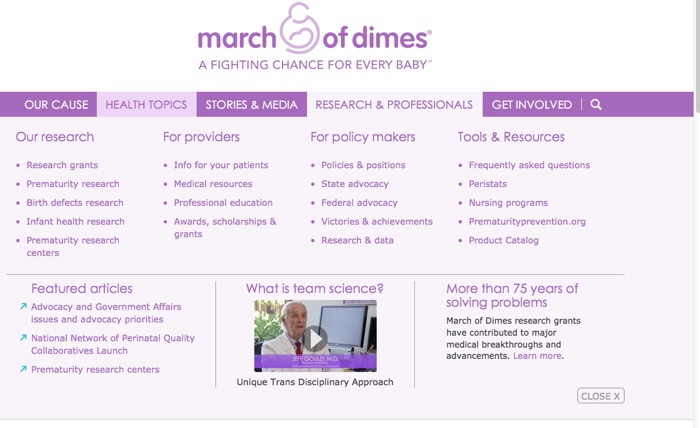
Design Your Website for Google Analytics in 7 Steps [PDF Checklist]
Today we’ll outline a few key website design considerations for designing your website to enhance your ability to gather that all-important click data.
Build with Subfolders not Subdomains
It’s easy to get erroneous data in Google Analytics when using a more complex website structure. Google Analytics doesn’t naturally handle them well and requires specific configurations when using multiple subdomains.
Tracking a single domain per property is the simplest Google Analytics implementation, which means your data has a better chance at being complete and accurate.
Move your blog and any other subdomains to a single root domain to track patterns across the entire user journey. If it’s not possible to maintain a single root domain and subfolders, try to scale back your subdomains to as few as possible.
Trade in Trendy Navigation for Usable Navigation
Website global navigation needs to do one thing: Help your most important user group accomplish their most critical tasks with as little confusion and frustration as possible.
Simple right? Unpacking that statement reveals a few critical questions that must be answered before that goal can be met:
- Who are your website users?
- What is your most critical (revenue-generating) group? E.g., a university website addresses alumni, community partners, current students, prospects, faculty, staff. Which group is most critical to the business?
- What is that primary group trying to accomplish on your website?
- How do those user tasks contribute to your business’ goals or KPIs and ultimately drive your business?
- What content and functionality will be needed to support that user journey?
Once you’ve answered those questions it’s time to start thinking about the global navigation. As you design the global navigation, keep a few points in mind to optimize your data acquisition and user experience:
Minimal navigation may be appropriate for websites trying to encourage users to discover and browse. Etsy, Pinterest, recipe, fashion or photography blogs all come to mind. However, when your website must facilitate goal-driven actions it’s better to provide a more robust navigation. University websites, government and service-industry sites all come to mind. The thing to remember here is that minimal does not equate to simple.
Don’t default to role based labeling in your top level navigation. According to Nielsen Norman Group, role-based navigation has been found to “…increase cognitive effort and user anxiety.” While “Clear language and mutually exclusive categories reduce the chance of harming the user experience.”
Don’t implement role-based navigation as an alternative to researching your users’ needs and strategically designing your navigation to best meet them. You can get great insights about your website users by using custom segments in Google Analytics.
Pogo sticking = messy data: When a user has to go into different sections of the website to identify what content is there it can set up a pogo-sticking scenario. If the information is not what they need they bounce back to the homepage or another section. If your data reveals high bounce rates on section landing pages and you’re using minimal navigation it’s a sign your users are “pogo sticking.”
Not only is it a bad user experience but it adds a lot of unnecessary and unhelpful clicks to your data. This indicates the need for a more robust or intuitive global navigation.
Multimedia Mega Menu! If research show that your users do have specific needs, questions and tasks to accomplish when coming to your website, consider implementing a robust global navigation.
Elements like images, icons, headings, buttons and video links can help you surface critical information in the main navigation because it doesn’t give equal treatment to all options as a standard text link sub-menu does.
Checkout these global navigation examples from March of Dimes and The Food Network.


URLS – Keep ’em Short!
Google Analytics provides precious little space in reports for the page URL. There is room for about 6 words (not including the root domain). Shorter URLs display better in search results and are easier for humans to read and interpret.
- Remove unnecessary words and stop words (like “and”).
- Don’t include dates in URLs
- Make URLs descriptive of the page (don’t use default schemes like “/page-id-23365/”)
- Use keywords in the URL if possible but don’t force it
Get an SSL to Unlock Referral Data
In Google Analytics, clicks from websites with an SSL to a site without an SSL are captured in the “direct” traffic channel.
The “direct” channel is a puzzle wrapped in a mystery, kind of. It’s a catch-all for clicks that don’t fit into the other channels. However, when a site with an SSL refers to another site with an SSL, that click is correctly recorded in the Referral channels report along with the URL. Correctly moving the click from the direct channel into the referral channel helps make your acquisition channel reporting more accurate.
In addition to improving data analysis, SSLs can help engender trust with users and give your site a small rankings boost in search results.
For more information about direct channel traffic clean up check out this article on Webris.
Design for Clicks & Page Views
Long, scrolling pages make gathering clickstream data difficult when there’s nowhere to click!
Make sure each page includes several potential user interactions such as: form submissions, linked calls to action, videos to play, or content to un-gate or download.
Track critical conversion events using page view goals (like the thank you page from a form submission) with the default Google Analytics setup by configuring a destination URL goal.
Track click events like downloads and button clicks using event tracking. Once event tracking is implemented these types of actions can be configured as goals as well. For example you can set a goal for a video play.
When a conversion or click event is setup as a goal you can get all kinds of helpful answers to questions like:
- “Which channel has the highest conversion rate?” (Default Channel Grouping)
- “Which social campaign has been most successful at driving lead generation?” (All Campaigns report)
- “What’s our highest converting demographic?” or “Where are we missing the mark with a valuable demographic?” (Demographics reports: Age, Gender, etc.)
- “Are we hitting our campaign goals on mobile devices? If not, what changes do we need to make to improve the mobile UX?” (Mobile Device Info report)
Event tracking requires some custom javascript implementation, so you’ll want to work with a developer or use Google Tag Manager (GTM) to implement this.
Include FAQ & Setup Click Event Tracking
The trick to using FAQ to deliver information back to you is to make sure there’s some user interactivity involved: a click at minimum. Use an accordion interface instead of static copy on a page. Then configure those FAQ “links” as Events.
This will count every time a user clicks on the FAQ question to get the answer. This can yield helpful information about what questions your audience has. You may then decide to promote that information to your homepage or global navigation.
Use Form Thank You Pages
If you use Gravity forms in WordPress, the default setting for the confirmation message is an in-line notification. Google Analytics can’t track that, so make sure to create a unique thank you page for each lead generation form and set these up as destination goals in Analytics.
Implement Site Wide Search
Users’ search queries can be gathered in an analytics report but only if you have site search functionality on your website (configured under View). Site search query information can be very helpful in identifying the informational needs and the language of the visitors on your website.
Topical Searches: If a search term comes up frequently, consider placing navigation to that content in the main navigation or utility nav.
Analysis of a higher education website found that both prospective students and current students used site search to look for “calendar” and “academic calendar” (the third most popular search term). A link directly to academic/activity calendars in the Utility Navigation of the website could help surface this website functionality.
Missing Content: When people enter questions into your site search it can help you identify information that should be added to the website, your FAQ, etc.
Users’ Language: You’ll be able to see the language of your users and incorporate that into your page copy. This not only helps surface information on site search but in Google Search as well. Using their language helps your content and message resonate with your audience so may have a positive impact on conversion and engagement rates.
Include a Privacy Policy
Enabling Google’s demographics and interests reports can provide more insights into your users, however, in order to access this data and be in compliance with Google, you must include a privacy policy on your website with information about cookies. It takes around 15 minutes to create a privacy policy using any number of free online tools like this one.
Get Our “Website Design for Google Analytics” Checklist
Download our handy Website Design for Google Analytics checklist and print or email these steps to yourself or your favorite website developer or designer!
